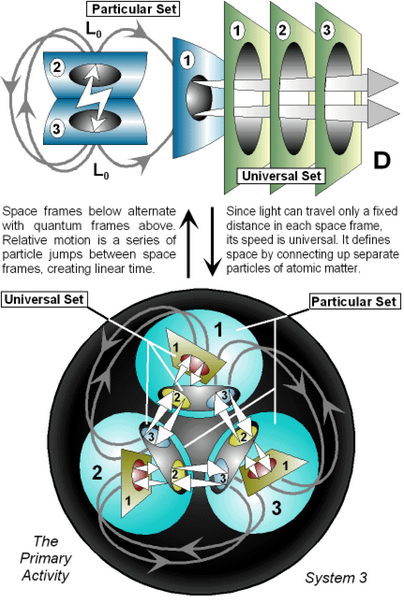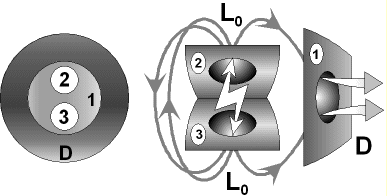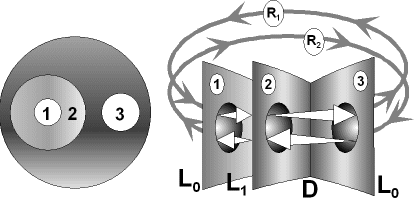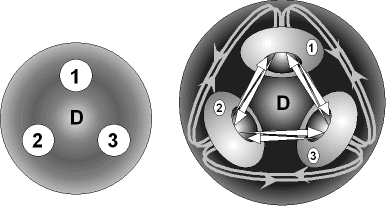Back • Return Home
System 3
Robert Campbell, 2005
The following is an illustration taken from Fisherman's Guide and Science & Cosmic Order showing how System 3 works. (For simple, basic information see Introduction to the System.) For example, the symmetries of the primary hydrogen atom are all represented. A description of how it works in relation to quantum atoms is given in Science & Cosmic Order. A very general overview is given in the article Quantum Atoms and Cosmology. A more advanced description of how System 3 generates atomic structure, space, and time is given in the article Atoms, Space-Time, and System 3. A description of how it works in relation to the human nervous system is given in Fisherman's Guide.
Fig. 1
How the Cosmic Order Proliferates
(A very brief summary up to System 3)
System 1 is universal wholeness. There is a oneness to the universe.
• Science seeks out universal laws to develop technologies that can be explicitly applied.
• Religions seek universal truths in personal experience that can provide implicit guidance.
• But undifferentiated oneness does not allow of multiplicity. There is both one and many.
• Oneness thus implies twoness and multiplicity. Otherwise there can be no phenomena in experience.
• There is a fundamental Rift in Wholeness. The Creative Process stems from the need to mend the Rift.
System 2 has two mutually related centers. Center 1 is universal and unique. It is One. Center 2 is many.
• There are many Centers 2, just as there are many people, but we share universal characteristics.
• Humans are both one and many. We share a universal Center 1 associated with our species.
• We sense our common humanity. We see a universal aspect of ourselves in others.
• Human individuals are particular examples of our common humanity, each with diverse traits and talents.
Two Modes to System 2 come into play, one that is subjective and one that is objective.
• We can sense our universal human aspect subjectively within us in our personal experience.
• We can also sense our universal human aspect objectively in others.
• Social values derive from the need to reconcile the two modes, in oneself in relation to others.
• The two modes transcend and subsume events in space and time. They have spiritual characteristics.
System 3 is implied by System 2 as it relates to the projection of three dimensional space and linear time.
• System 3 is generated by two sets of three centers. One set is universal. One set is particular and many.
• There are only four ways that three centers can relate to one another with respect to inside and outside.
• The four ways define four Terms. Two are universal and unique. Two of them are particular and many.
• They work in pairs that define two modes in the projection of a holographic movie. It is a cosmic movie.
The primary projection of space derives from System 3. It is the primary activity.
• A single space frame is shown at the bottom of Figure 1. It represents a single atom, one of many.
• The subjective universal set tunnels through the centers of each particle set within, linking them in pairs.
• A quantum frame (top) shows one of many atoms as a timeless energy bundle inside the universal set.
• The universal and particular sets in the quantum frame have an inverse relationship to the space frame.
• All atoms are formless energy bundles in the quantum frame or Void, like the empty screen in the movie.
The primary projection of linear time derives from a series of recurring space frames just as in any movie.
• The still particle frames alternate with timeless quantum frames in the synchronous movie projection.
• Since light has a universal relationship to each atom, it integrates the fabric of space in each frame.
• Relative motions cause the movie to get out of sync accounting for a variety of relativistic effects.
• Relativistic balances occur in a variety of ways that maintain a preponderance of coherence in the movie.
• The relative cyclic motions of galaxies is implicated in the regeneration of their stellar populations.
• In this context, Particular Center 1 is the closed Photon energy shell. C2 is an electron. C3 is a proton.
For more, see the articles Atoms, Space-Time, and System 3 and Quantum Atoms and Cosmology. Those interested who have a good understanding of science are referred to Science & Cosmic Order.
The Four Terms of System 3
The diagrams are reproduced from Fisherman's Guide. The descriptions are simplified.
Reminder Note: Active interfaces between a common inside and outside are represented by active surfaces consistent with System 1. They are called Centers (C1, C2, etc.) since each has an active center designated by Light (L) that relates across one or more active interfaces to a common periphery represented by Darkness (D). Everything that we perceive in phenomenal experience involves active interfaces. Everything from atoms and molecules to light itself consists of a form of electromagnetic energy and its derivatives relating to itself across active interfaces. Most active interfaces or Centers are represented by plane surfaces of indefinite extent. This generally indicates archetypal characteristics that are not necessarily bounded in themselves. For example, in the human nervous system it may represent the processes of cells, but not necessarily all of the cells in one human body, only those affected, but it equally applies to all human bodies. Closed Centers are represented by a Triad of ellipses. Only triadic relationships are mutually closed and defined in spatial extent, in the way that System 3 defines one atom here in a Space Frame. An electron is spatially distinct from a proton and from the photon energy shell that defines the whole atom. In a biological context, the triad relates to Cells, Organs, and Host human being. The three are intimately related and mutually dependent, yet each has a closed surface that can be identified in space and time. The Universal Set that links up the three Centers of the Particular Set has open Centers since they apply to all Particular Sets. In the Quantum Frame, the Particular Centers are also open since they are integrated as the Universal Idea, Center 1.
Universal Term 1: Idea → Routine → Form
Ideas C1, direct Routines C2, which result in Form C3 consistent with the idea. This universal Term applies to all creative activity. It has discretionary characteristics. As such, it can access relevant Particular Ideas represented by Term 3 below, for recall from the Void as illustrated in the Quantum Frame above. The centers are open and relate to all of a kind in context.
Fig. 2
Particular Term 3: Idea = (Routine = Form)
The Routine C2 and Form C3 interfaces close face to face. They coalesce as One. Each relates inside the other thence outside through the Idea interface C1. They are C1. The Routine and Form are a coalesced element of technique that is the Idea. The three centers are intimately married as a quantized element of memory in the Void. C2 and C3 via C1 simultaneously realize the internal and external aspects of the creative process. It is an eternal relationship. It is formless and timeless. All such Particular Sets as quantized elements are holistically integrated in the Void and are synonymous with the Universal Center 1 in Term 1 above. The Universal Idea is the integrated whole of all Particular Ideas of the universe. This is represented in the Quantum Frame of the System 3 diagram.
Fig. 3
Universal Term 2: Idea → Routine ↔ Form
Two Relational Wholes are defined and designated as R1 and R2. In R1, the Idea C1 relates from inside out through the Routine interface C2 to the Form interface C3, which is perceptually transposed and facing back toward C2. C1 is subjective to C2. C3 is objective to C2. There is feedback via the counter-current Relational Whole R2. Idea gives Form via a Routine of activity and the Form feeds back via the Routine to find consistency in the Idea. This universal Term defines a subjective and objective aspect to the creation of all Particular things, from Atoms to TV sets. The Idea is realized in the Form via the Routine. The Universal Set does not itself exist as a thing in Space and Time. It is archetypal. It is confined within the Particular Sets. It is illustrated tunnelling through and linking up the Centers of the Particular Term 4 in the Space Frame of the System 3 diagram above. Each of the three Centers of each Particular Set in Term 4 below are intimately bound as one thing that exists in Space and Time. We recognize each Particular thing as something that exists.
Fig. 4
Particular Term 4: Idea <=> Routine <=> Form <=> Idea
The three Particular Centers Idea C1, Routine C2, and Form C3 are mutually separate and thus spatially closed as Particular things that are nevertheless intimately bound together as One Particular Thing. Each intimately bound Particular Set is spatially separate from other Particular things of the same kind, just as all hydrogen atoms are mutually separate although each consists of an intimately bound photon, electron, and proton. And each human being consists of an intimately bound mind, spirit, and body. Each of the three Particular Centers are mutually bounded as separate and distinct, yet they are mutually related by counter-current identities as in the Universal Term 2 above. They are mutually identified as having an objective and subjective aspect by their mutual relationship, linked as it is by the Universal Set. The Universal Term 2 intimately links up each of the Particular Centers in pairs, one pair at a time from Idea to Routine, to Form and back to Idea, in that that self-consistent order. In this way, each of the three Particular Centers shares a common Universal Center and a common Universal Periphery, consistent with System 1.
Fig. 5
Note: The sole evidence for an expanding universe is the red shift of distant galaxies. Big Bang cosmology is erected on this single piece of observed fact, together with the relativistic assumption that space-time form a hypothetical continuum in four dimensions. But the very nature of Planck's universal quantum of action, and observed quantum events, clearly indicate a basic discontinuity in space and time, just as indicated by System 3. The red shift of distant galaxies may therefore be explained by relative synchronous distortions over the enormous spans of time that their light takes to reach us. A new cosmology thus emerges of galaxies eternally refluxing their stellar populations according to the way the cosmic order works. Otherwise, Big Bang theory remains based on empirical concepts and laws derived from the physical universe that are negated in the instant of creation. Science cannot address this basic contradiction in the theory. And the inconceivable instant of creation from absolutely nothing must forever remain without confirmation in experience. The theory divorces us from our own understanding. It erodes at the foundations of human values. These same objections do not arise with the way the System works as an expression of the cosmic order. And it offers new avenues to understand many perplexing phenomena, including the background cosmic radiation, distant quasars, missing mass, the differential rotation of the sun, and other observations.





